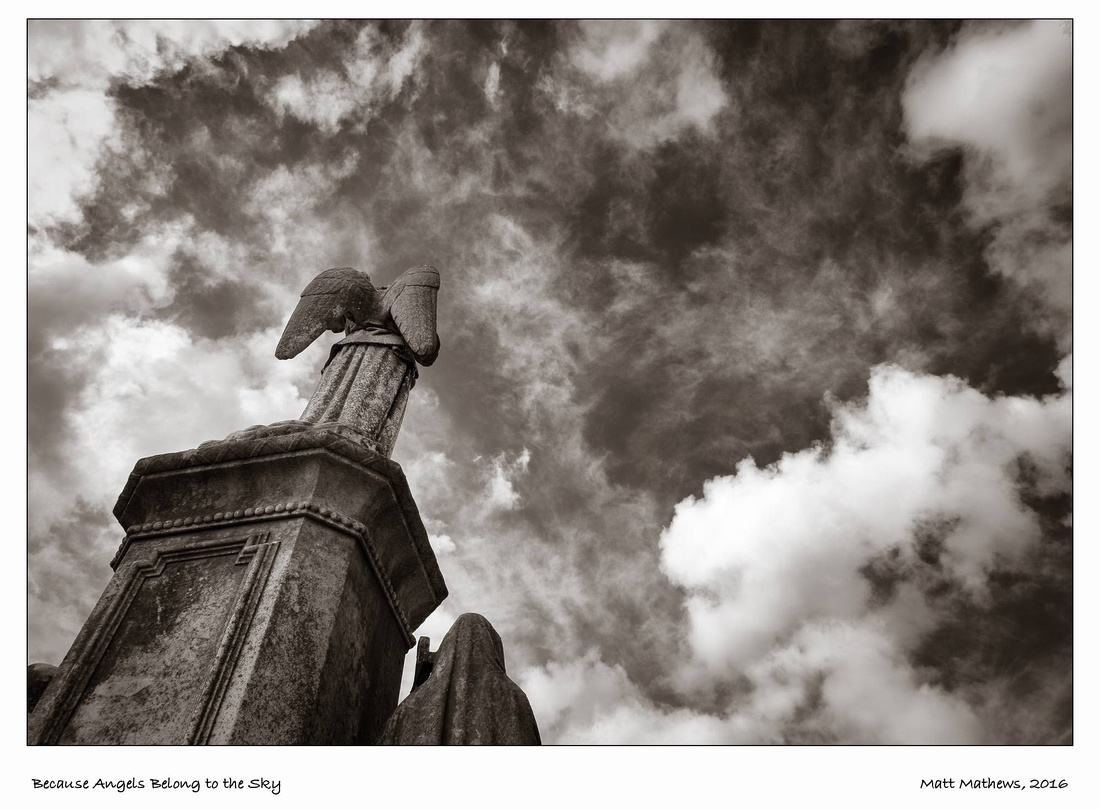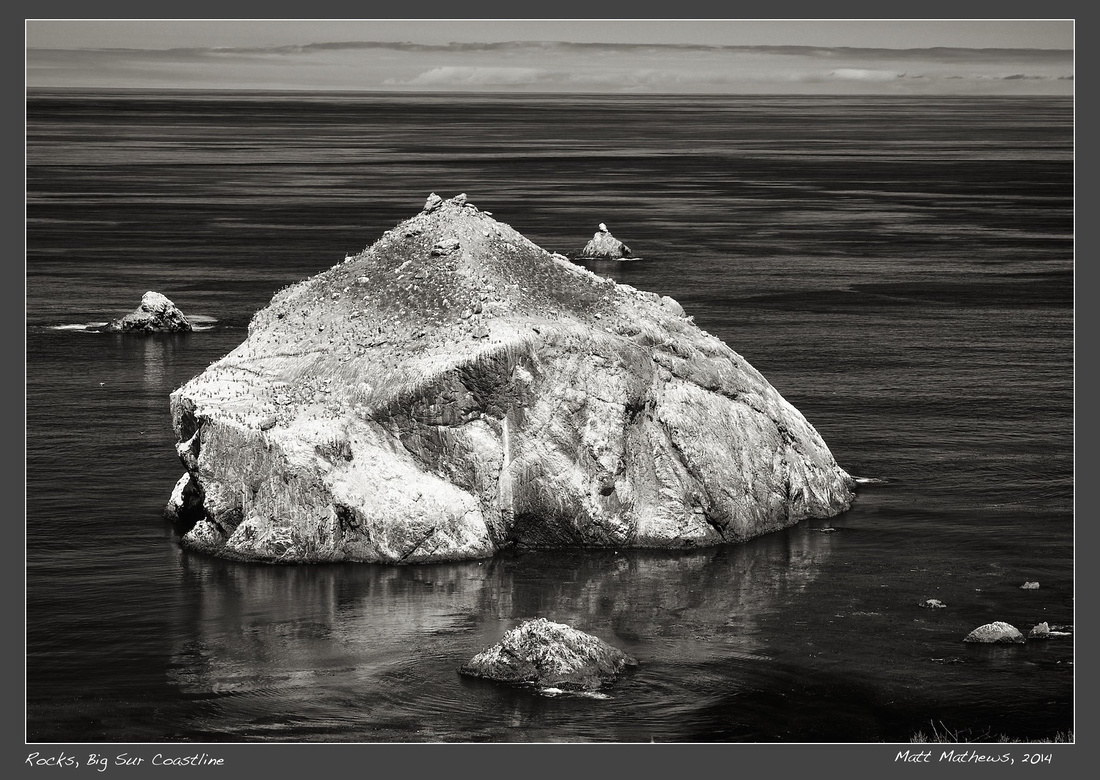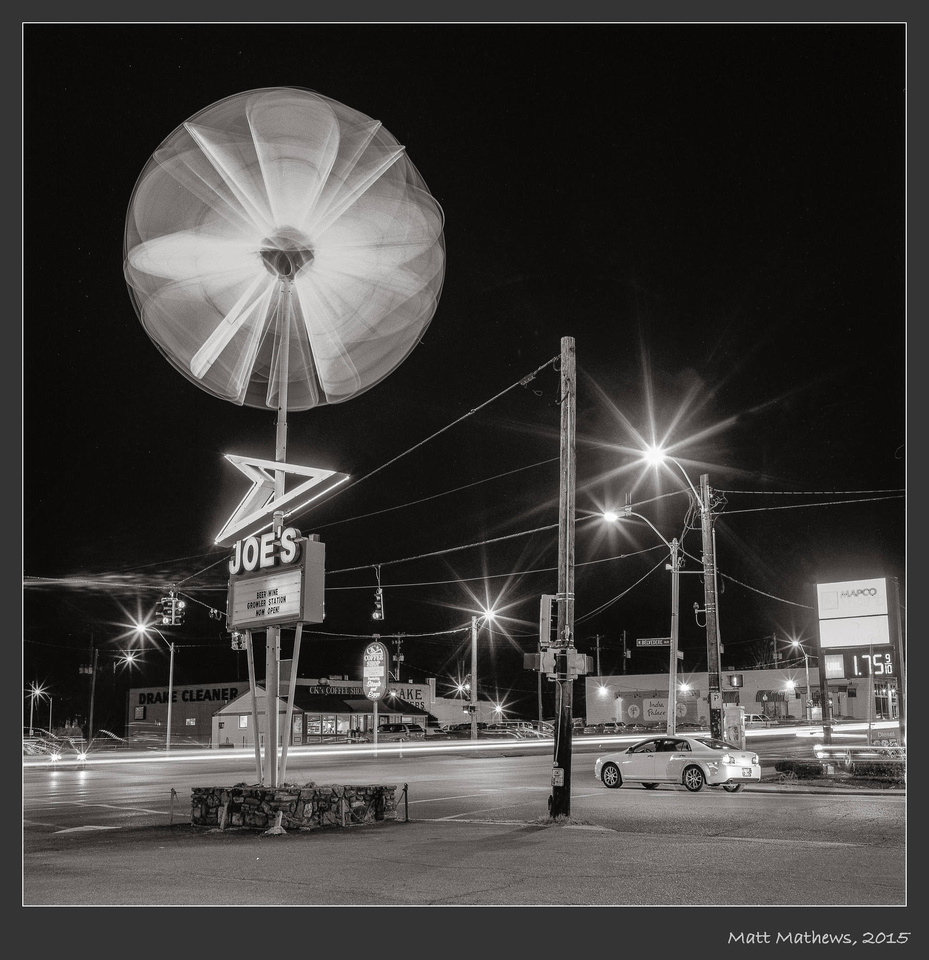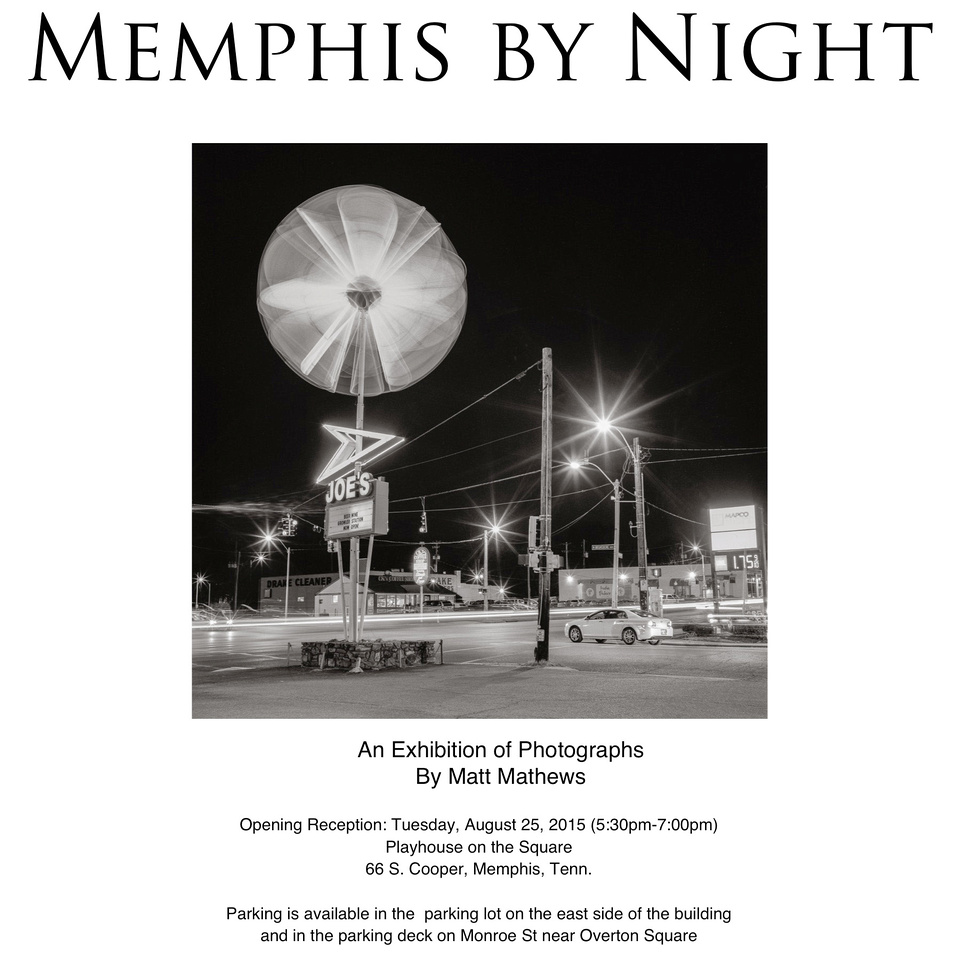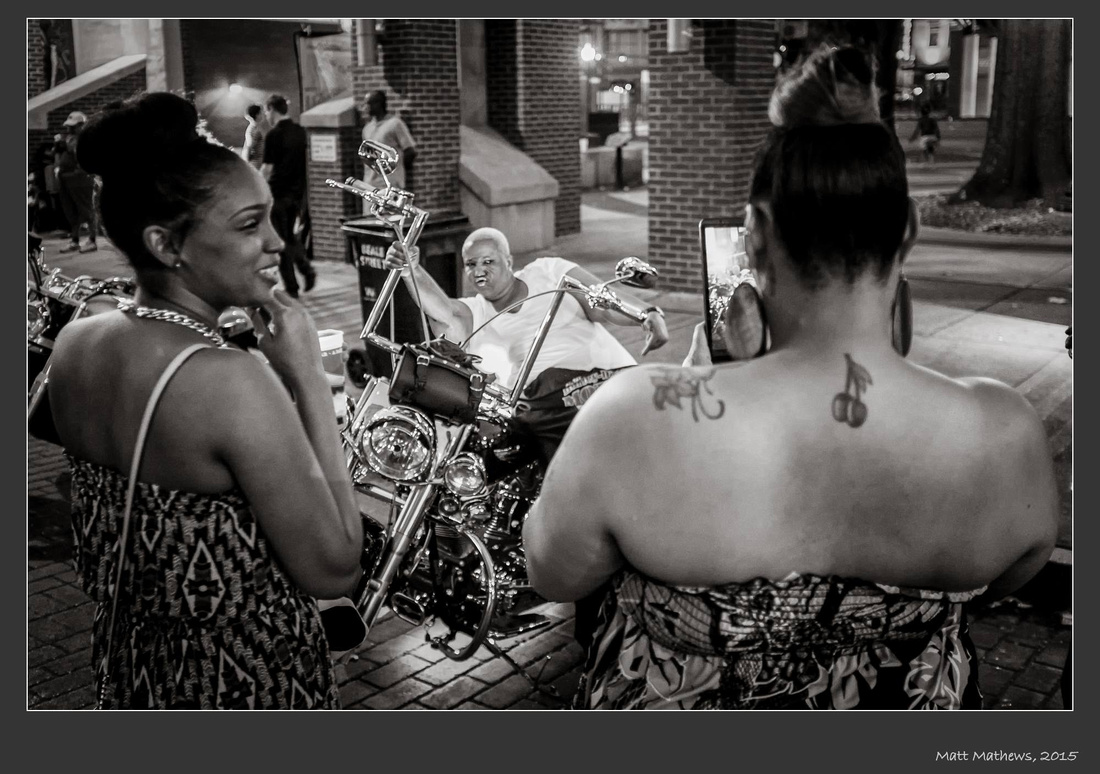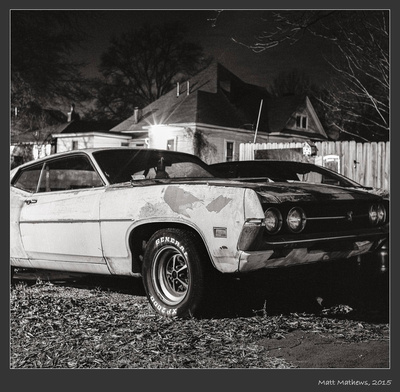Because Angels Belong to the Sky
During 2016, I am serving as the David McCrosky Photographer-in-Residence at historic Elmwood Cemetery in Memphis, Tennessee. I have photographed at Elmwood for many years, but not with the frequency or intensity that now accompany my role there.
Elmwood Cemetery is many things. It is the resting place of countless citizens of the city, many of whom shaped its life deeply and even more who did not. This is no indictment of the latter, but its own kind of praise.
When I walk among the eighty acres of statuary at Elmwood, I find myself pulled in two directions. I am first drawn to the large, exotic statuary inflected with a heavy Victorian accent -- towering angels, childlike cherubs, angelic nymphs, stern-faced busts, inscriptions of florid prose and sacred verse. There is even a lexicon of symbols, garlands, flowers, obelisks, pillars, and cisterns that translate into stone the nineteenth-century language of death. It is a beautiful sight to behold, and a photographer's playground.
And yet, there is another side to walking at Elmwood that draws me as well. It involves seeing the gravestones of the average people, the ordinary folk whose graves are easily overlooked amid the extravagance of the Victorian garden with its hovering flock of angels. These are the gravestones of infants and children, often small and nameless, bearing only the word, daughter or son, or in some cases, only two initials. And then there are other gravestones, many broken and fallen, whose letters have become unreadable, worn smooth and indistinct by a hundred or more years of weather. And still again, there are the more recent, plain gravestones bearing only names and dates, as noticeably short on sentiment as they are on aesthetic appeal. It is easy to walk past these rather plain, functional memorials in search of the angels, generals, mayors, Civil War soldiers, Memphis's first black millionaire, and the martyred Episcopal nuns of the yellow fever epidemic of 1878.
This visual tension created by the variety of memorials awakens ambivalence in me. The most ornate gravestones and memorials are there to coach our memory about the people at rest beneath them. Such coaching, of course, is as notoriously lopsided as the markers themselves, many of which, like little leaning Towers of Pisa, have settled with time and now stand awkward and crooked. If we are honest, we know that these folk were not as angelic as the stonework above them suggests. They trafficked as much in power as in virtue. And yet, we or their loved ones prefer to re-remember them angelically, at least for awhile, until grief is far enough distant to allow for honesty.
But then there are those ordinary markers of the average folk, the graves of a sort of blue-collar dead people. Their gravestones coach us less, leaving us only with naked facts, a name with only the dates of birth and death etched artlessly on unadorned stones that look mass produced. Perhaps these are the more honest memorials, seeking only to mark an ordinary life lived and lost. They make no bid at angelic re-remembering. There is no effort to win for the ones below a redemption from all ambiguity and ordinariness. Unlike the large crypts and towering memorials that punctuate the cemetery around them, these smaller, plain markers seem to make no claim at immortality through stone. But surely, the lives of those beneath them were as full as the lives of the white-collar dead people who seem to hold them hostage in the cemetery. Surely their loves were as deep, their hopes as intense, their joys as real, their suffering as intense, and their families as important as those of the angels.
When I walk and photograph at Elmwood, I am drawn to both kinds of markers. As a photographer, I am drawn to the memorials adorned in Victorian excess, desperately seeking to coach our memory of the dead and achieve for them a kind of immortality in stone. I need them because I know that the same longing for recognition and permanence and the same temptation toward antiseptic memory well up in every human heart, my own included. As a theologian, I am drawn to the plain markers of the average people, for they offer a more realistic assessment of our days and lives. There is no attempt to accomplish in stone what they did not accomplish in life. They lived and loved, worked and played, and celebrated and lamented like I do. And then they died. And so will I.
As lovely as the angels are, we are not them. We belong to the earth below with all of the ambiguities, possibilities, and partialities ingredient in ordinary flesh.
In the end, it is only the angels who belong to the sky.
Desire and Silent Rebellion
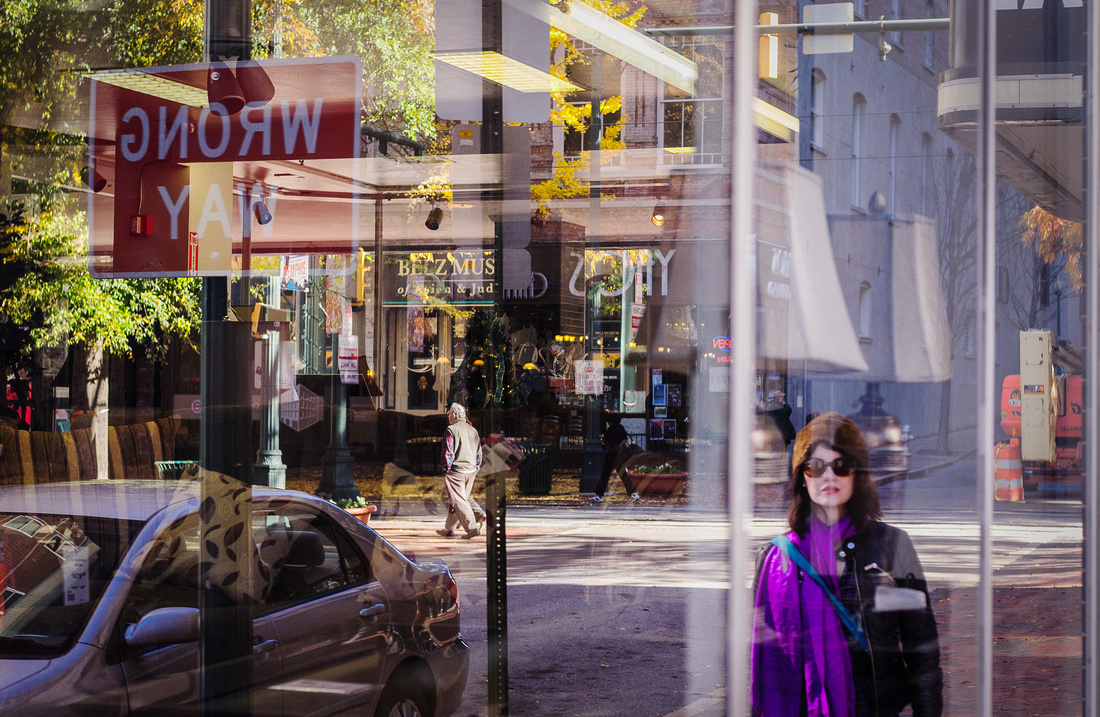
 "Our hearts are restless until they find their rest in thee, O God."
"Our hearts are restless until they find their rest in thee, O God."
-Augustine, Confessions, Bk. 1, Ch. 1.
"...[A]s [the human] will is attracted or repelled by the variety of things..., so is it changed or converted..."
-Augustine, The City of God, Bk. 14, Ch. 6.
Human beings are shot through with desire. We hunger and thirst, ache for companionship and burn with sexual desire, and we long for things, some good, some bad, most a tangle of both. Augustine knew that human beings do not merely have desires; we become what we desire. The objects of our desire shape us into the kinds of people we become. What we desire hones our attention and forms our habits, blinding us to some things, highlighting others. How we see, what we see, and who we become are intimately and complexly commingled. So, while it is true that we have desires; it is perhaps more true to say that our desires have us. We become what we desire.
The windows along Main Street are intimately connected to this economy of human desire. In them we see things and promised experiences vying for our dollars, time, and loyalty. The carefully arranged tableaus and mannequins, collections of curios, well chosen words, and price tags are not simply selling things; they are seducing us with a vision of fully satisfied human desire.
The windows offer a kind of ersatz salvation, and much of the power of consumerism lies precisely here. While it purports simply to be meeting our desires, consumerism in fact creates those desires, shaping and reshaping them ever anew by holding before us an endless array of new and improved things to be easily acquired. The power of consumerism is not so much that it offers an array of things to satisfy our natural desires for food, shelter, clothing, recreation, and companionship. Rather, the power of consumerism resides in its capacity to redirect and exaggerate these desires by attaching them to things that have been imaginatively resignified to become bearers of an elusive but powerful vision of perfect human fulfillment.
While consumerism promises perfect fulfillment, that after all accounts for its irrestibility, it in fact depends upon the continued disappointment with the things we already own to fuel a fresh and even more intense desire to acquire the latest things. Buying the lingerie found on unrealistically lithe mannequins in boutique windows will make your body desirable again in his eyes. You will be young again. You will be thin again. You will be loved again. Buying the oversized truck found in the walk-in windows at the dealership and advertised with the deep, husky male voice in the electronic window on your living room wall will settle questions about your masculinity. You'll be man enough for her. You will be loved again. Buy the larger home pictured in the windows of the real estate office and fill it with this season's newest furnishings from the furniture store windows, and your family will know domestic bliss, and your neighbors will know your social worth. Order from the menu in the window of the trendy restaurant or buy her a diamond from the jewelry case, and the spark of romance and sexual excitement will return.
While the windows of Main Street proclaim a carefully marketed gospel of commodified desire, these same windows are engaged in a silent rebellion. If you look at them rather than through them, if you look at the play of reflections with their odd juxtaposition of elements from the street that superimpose themselves upon the carefully choreographed tableaus of the marketers, you see their silent rebellion. Street signs, blurred faces with unguarded expressions, inverted words, cars, pavement, paint, and foreign signage crash disruptively into the carefully planned, controlled scenes behind the glass. Sunlight glints unpredictably and the changing play of clouds and sky appear and reappear unpredictably minute by minute. If you pay attention to the reflections, you can too easily overlook the message behind the glass. And when that happens, the windows have won their rebellion.
Despite every attempt to control what we see in them, and despite every attempt to create and direct our desire through what is seen in them, the windows won't fully cooperate. In the play of reflections, we find accidental beauty, visual riddles replacing the marketer's confident slogans, indeterminate visual possibilities that can free our imagination and liberate desire from the lie of owned things.
Yes, the windows are engaged in a silent rebellion against those who would control them, and through them, control us.
The Shattering of the Vessels
In the sixteenth-century writings of the Jewish mystic, Rabbi Isaac Luria Safed (1534-72) there is an intriguing creation story known as "The Shattering of the Vessels."
God, the story goes, created the world by pouring primordial, divine light into ten fragile vessels that would become the world. The primordial light -- the bearer of all beauty, goodness, and righteousness -- however, was simply too much for the fragile vessels, and they shattered into many shards, scattering their light into the world as innumerable sparks. These fragments of light are often hidden among the clay shards, held in bondage by the suffering and brokenness of the world. God then created human beings for the purpose of gathering up all the sparks of divine light scattered to the four corners of the earth. The good Jew is called to seek out and liberate the sparks of primordial light that bear God's presence in the world. To do so, is to pursue tikkun olam, "the repair or healing of the world."*
In this Kabbalist tradition, we find a powerful metaphor not only for faithful living but for creative photography. The metaphor suggests at least three things, the first about the object of our interest, the second about the impulse to create, and the third about the power of the beauty ingredient in resplendent light.
Photographic creativity is about searching out the delicate, scattered fragments of light that have already spilled into the world. This beauty is already there. You just have to find it. It's not in the eye of the beholder. It's in the nature of things. A photograph is a good one to the extent that it bears witness to those often overlooked but always given fragments of splendorous light already in the world. Photographs are invitations to liberate these sparks of light from bondage to the stale, habituated, hurried ways of seeing that conceal them from us.
But why do photographers search out these fragments of light? We do so not merely to make a beautiful image that pleases the viewer. We seek something deeper than the viewer's pleasure and approval. Photographs aim at a greater end, "the repair and healing of the world." Creativity is our attempt, often halting and always partial, to touch something real and outside of ourselves and to be healed by it. The creative gesture is also an invitation to others to touch it and be healed as well.
Artistic pursuit is thus not about a tortured artist expressing some fictional inner genius, inflicting the vagaries of her or his tumultuous inner life on the rest of us. Nor is it about creating pretty pieces to hang as ornaments on the wall above the sofa. Rather, the artistic pursuit of beauty reveals a longing for connectedness with the primordial light that is the source and end of all things. Creativity is at once the artist's own attempt and invitation for others to participate in the wholeness, restoration, and healing that lies at the heart of the world. To know the beauty of the light is to experience oneself as part of something much larger and infinitely more interesting than oneself. To experience such beauty, or better, to soak in it over time, is to live proleptically into wholeness, participating in the unifying power that creates, sustains, and directs all that is.
To experience the beauty made possible by resplendent light is both unsettling and liberating, troubling and reassuring. It is unsettling and troubling because having dwelt in its midst, we can no longer casually overlook the brokenness of our world that hides its sparks. We sense the unsettling dissonance between the fragments of light and all that conspires to conceal them. Contemplation flows into action, but an action that always returns again to the contemplation of the liberating, reassuring light that saturates all things.
-------------------------------
*http://www.tikkun.org/nextgen/how-the-ari-created-a-myth-and-transformed-judaism
For the Healing of the Nations
Amidst the Great Depression and rise of fascism in the 1930s, the French social documentary photographer, Henri Cartier-Bresson criticized Ansel Adams for neglecting to photograph the social crises of the day. "The world," he said, "is going to pieces, and Adams...[is] photographing rocks and trees."*
Cartier-Bresson was right about the world in the second quarter of the twentieth century. It was coming unraveled. The United States was in the depths of the Great Depression and staggering rates of unemployment, long soup lines, and widespread homelessness seemed overwhelming. Even the land was in exile, with its fertile topsoil carried off by the winds of the Dust Bowl. For many, the American dream seemed a lie, and it lost its mythic power over their imaginations.
Fascism was on the rise in Germany, Italy, and Japan, and a second world war seemed merely a matter of time. The Ku Klux Klan was at its height in the United States, and with it came unparalleled numbers of brutal lynchings and institutionalized racial violence. A good bit of Cartier-Bresson's own groundbreaking social documentary photography would depict this world governed by fear, violence, scarcity, social dislocation, and racial animus.
If Cartier-Bresson was right about the world, he was wrong about Adams. Adams was not insensitive to the social realities unfolding around him. He felt them keenly. But he kept on photographing rocks. "We need a little earth to stand on," Adams said, "and feel run through our fingers."* Adams knew that there was a deeper reality beneath the fears and immediate crises of the day, a deeper beauty resident in the natural world, and that contact with it was essential to human flourishing, essential to what the wild-eyed apocalypticist called "the healing of the nations."** Tempting as it was to turn his camera in service of social and political movements of the day, Adams kept it trained upon rocks, trees, lakes, and snowstorms because he knew that there was a healing power in natural beauty, a power that connected us with primordial goodness, hope, and receptivity to the mystery and giftedness of all things. To experience such beauty was to feel in one's gut the cosmic benevolent goodness disposed toward life, justice, and the harmonious existence of all beings.
Without the healing balm of beauty, the energy of social activism would flash bright but emit no heat. Or worse, it would get fused with the bitterness and blind self-righteousness that often imperil zealous do-gooders. To neglect this beauty was to neglect the ontological grounding of all being, even if this neglect clothed itself attractively in the immediate gratification that can come from social activism and art for a political cause. Adams knew that ethics needs metaphysics; that the pursuit of the True and the Good must always also be the pursuit of the Beautiful at the same time.
Adams's was not a call to an aesthetic escapism but rather to groundedness, to the cultivation of the soul, and to a connectedness with natural beauty that issues in life, joy, and gratitude. These experiences leave less room for the chronic anger, bitterness, and cynicism that threaten to engulf us in an age of violence, fear, and racism.
In our contemporary world so similar to the one described by Cartier-Bresson, we would do well to pause and linger with Adams's insight. His was not a call to quietism. He did, after all, photograph the Manzanar Internment Camp and the Japanese American citizens imprisoned there by racist fear masquerading as national security, and he released those photos into the public domain to express his moral outrage and elicit it from Americans. He was also a key figure in advancing the cause of early environmentalism, writing thousands of letters to politicians and editors of newspapers. But in the end, for Adams, the social world was grounded in the natural world, and we fail to see this at our spiritual peril.
Social activists, the victims of injustice and violence, and the morally indifferent must all look at the rocks from time to time. Out of the depths of their mysterious beauty might come the transforming grace that will rescue all of us from self-righteousness and alienation. Out of the rocks may come "the healing of the nations."
____________________
*Quoted in "Ansel Adams: A Documentary Film". Produced by Ric Burns in conjunction with PBS's American Experience Series. Transcript available at http://www.pbs.org/wgbh/amex/ansel/filmmore/pt.html.
**Revelation 22:2
Storefront Windows and Cognitive Flexibility
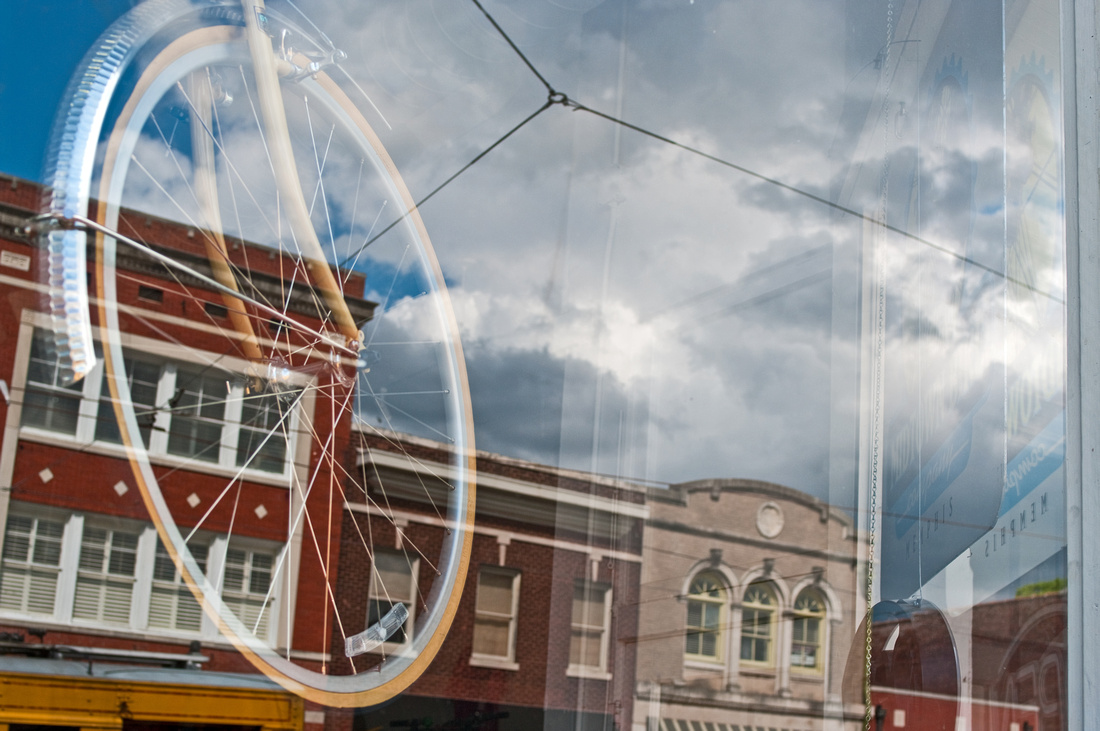
 Wheel in the Sky, 2010
Wheel in the Sky, 2010
For the better part of the last decade, I have been photographing on and near Main Street in downtown Memphis, Tennessee. When I began photographing there, I wasn't clear what I was trying to communicate.
In discussing his own photography, Sam Abell has remarked that he often finds that he photographs "ahead of himself;" that is, his visual instincts and creativity impulses lead him out into the world to make photographs of particular subjects before he can understand or articulate why. I believe he's right; I, too, often photograph ahead of myself. Only later do I find words to explore what I was up to with the camera.
My attention has gradually settled on the kaleidoscopic reflections found in storefront windows. As these reflections mingle with the interior spaces and objects behind the glass, the scenes become intriguing, beautiful even, with their odd play of vibrant colors and juxtaposed elements. The scenes are often reminiscent of the surrealistic paintings of Salvador Dali or the collages of school children.
Wheel in the Sky represents one of my earliest moments of insight into the windows project. It was made on a winter day in 2010, and grey storm clouds were giving way to blue skies. As I looked up at a bicycle suspended in the window of a shop, I saw more than a bicycle. I saw an odd intermingling of nature and artifice, clouds and machine, bricks and blue sky. I sensed the oddity of it as well as its peculiar beauty.
Like other photographs in the collection, Wheel in the Sky offers resistance to our ordinary, habituated ways of seeing. We are trained to peer through windows to see what lies beyond, to home in on what really matters. Ours is a penetrating gaze that is quick to discard the ephemera in search of what is solid, stable, and fixed. It is a serious seeing, a seeing with purpose. Things are quickly sized up for their utility or market value. Our visual habits betray our drive for mastery, control, and use. These same habits also betray our casual disregard for wonder, intrigue, and curiosity and our neglect of that felt sense of mystery that wells up within us in the presence of surprising, transient beauty.
In the windows, things are tangled in reflections that are ungraspable, useless, and immaterial. The scenes are riddled with insubstantial forms, and they extol mere appearances above hard realities. Mastery yields to mystery, the practical to the imaginative, and possession to delight. They call for and awaken cognitive flexibility, a spiritual agility that bends gracefully toward wonder, curiosity, and openness.
And in the end, this cognitive flexibility, together with its attendant virtues of soul, may be a vital part of what rescues us from the rigidity, bitter alienation, and xenophobia that seem to animate a new strain of American fascism.
Welcome surprises and savor the strange. Look at the windows rather than through them from time to time.
Purchase Prints of "Memphis by Night" or Other Collections
In anticipation of the holidays, I'm announcing the availability of prints from my "Memphis by Night" Collection. If you would like to purchase a print, please contact me ([email protected]). Please identify the photograph(s) you would like to purchase using the thumbnail number(s) visible in the online gallery.
I am offering the following purchase options for these open-edition, signed prints.
Large Prints
Mounted and matted unframed print for a standard 16"x20" frame: $75.00 (actual print sizes is 11.25"x11.25")
Mounted and matted print framed in either a 16"x20" or 18"x24" black gallery-style frame: $150.00 (actual print sizes are 11.25"x11.25" or 13.25"x13.25")
Small Prints
Mounted and matted unframed print for a standard 11"x14" frame: $40.00 (actual print size is approximately 7.75"x 7.75")
Mounted and matted framed print in an 11"x14" black gallery-style frame: $75.00 (actual print size is 7.75"x7.75")
Please allow 10 days for delivery. Order deadline for delivery by Christmas is December 15.
If your order requires shipping, I will simply add only the actual cost of shipping. Add an additional 5 business days to delivery time.
Finally, if there is a print from a different collection in my gallery that you'd like, I'd also be happy to do one for you at the prices listed above.
Exhibition and Reception for "Memphis By Night"
"Memphis by Night," my exhibition of photographs that explore our city after sunset will be open to the public from July 31 through September 12, 2015. The collection may be viewed in the first floor gallery at Playhouse on the Square. Details below.
The Artist Reception is Tuesday, August 25 from 5:30-7:00pm and is free and open to the public.
Reflections on Black Women, Funk, and Beale Street
Funk on Beale Street, 2015
I will never understand what it means to be a black woman in America, at least not fully. And I am not alone. But this fact does not exempt me from the obligation to try. Nor does it mean that I cannot come to understand at least something about it if I try really hard.
In Shoes That Fit Our Feet: Sources for a Constructive Black Theology (Orbis, 1999), Dwight Hopkins explores two polarities that exert a powerful influence on the lives of many African-American women. Borrowing from the colloquial discourse of black women, Hopkins names these polarities thing and funk.
Thing names all the forces of American culture that conspire to objectify black women, that work to erase their humanity and render them invisible except when we need them present to be exploited economically, sexually, and culturally. Thing happens when the ideology of whiteness constructs a black woman's identity into an over-sexed exotic other, a welfare queen, or a asexual Aunt Jemima whose nannying is as simple and sweet as tasty syrup on pancakes. Thing happens when we are unable or unwilling to see the myriad of successful black women who disrupt these cultural constructions. And thing happens when we explain away the success of such women as exceptional and thus anomalous, forgetting their names even as we make them "a credit to their race."
It's easy to internalize thing's lie. Toni Morrison and Alice Walker have taught us as much in The Bluest Eye and The Color Purple. The internalized lie shows itself in guilt, self-doubt, and a sense of defilement that wear away at the bodies and souls of black women. A healthy sense of one's worthiness and an appropriate love of self are paralyzed by the venom of shame and a sense of powerlessness.
Funk is hard for white people like me to understand. It seems so loud, so boistorous, and, well, just so black. It makes us uncomfortable. It does so because it protests and resists the stranglehold of our whiteness. Funk erupts in gesture, dialect, slang, art, and in the occasional wagging of a black women's finger at a condescending clerk, nurse, or theologian. Its roots are deep, reaching back to "sassing" the master on the plantation. It was and is resistance to thing. It is a stubborn insistence on somebodyness; a refusal to conform to white expectations for black being. It is soul. It is agency. It is an assertion of her genuine self over against the false constructions of her identity as welfare queen, over-sexed exotic other, and benign nanny. Funk is gospel, grace, and judgment wrapped into one.
But funk is protest in the form of a zesty celebration of life. It celebrates embodiment and soulful sexuality, redeeming them from white fantasy, fear, and violence. It celebrates slang, gesture, and rhythm, offering redemption from "respectable" speech and the politics of respectability required by thing.
Funk is fun. Funk is playful. Funk is parody. Funk piles atop male motorcycles and strikes an overdone, playful pose of parodied seduction and satirized femininity that unmasks the absurdity of our dangerous cultural myths. It's the exuberant, unpoliced celebration of the whole self as it triumphs over thing. If thing is death, funk is life.
Hopkins has helped me understand a thing or two about the experience of many African-American women. I don't fully understand, of course. And, if I'm honest, funk still sometimes makes me squirm a little. It's difficult to confront my complicity in thing as an upper middle class white man. It's much easier to deny thing's existence, insisting on the tired tropes of the importance of personal virtue and hard work abstracted from historical and social analysis. But it's even more difficult to muster some funk of my own to resist it.
In the end, Funk on Beale Street is an invitation "to play that funky music, white boy"* and by so doing deliver my white pigment from the ideology of whiteness that often enslaves it in its own kind of soulless thing.
-----------------------------
*"Play that Funky Music" was written by Rob Parissi and first performed by the band Wild Cherry in 1976.
Reflections of a Flaneur: Memphis by Night
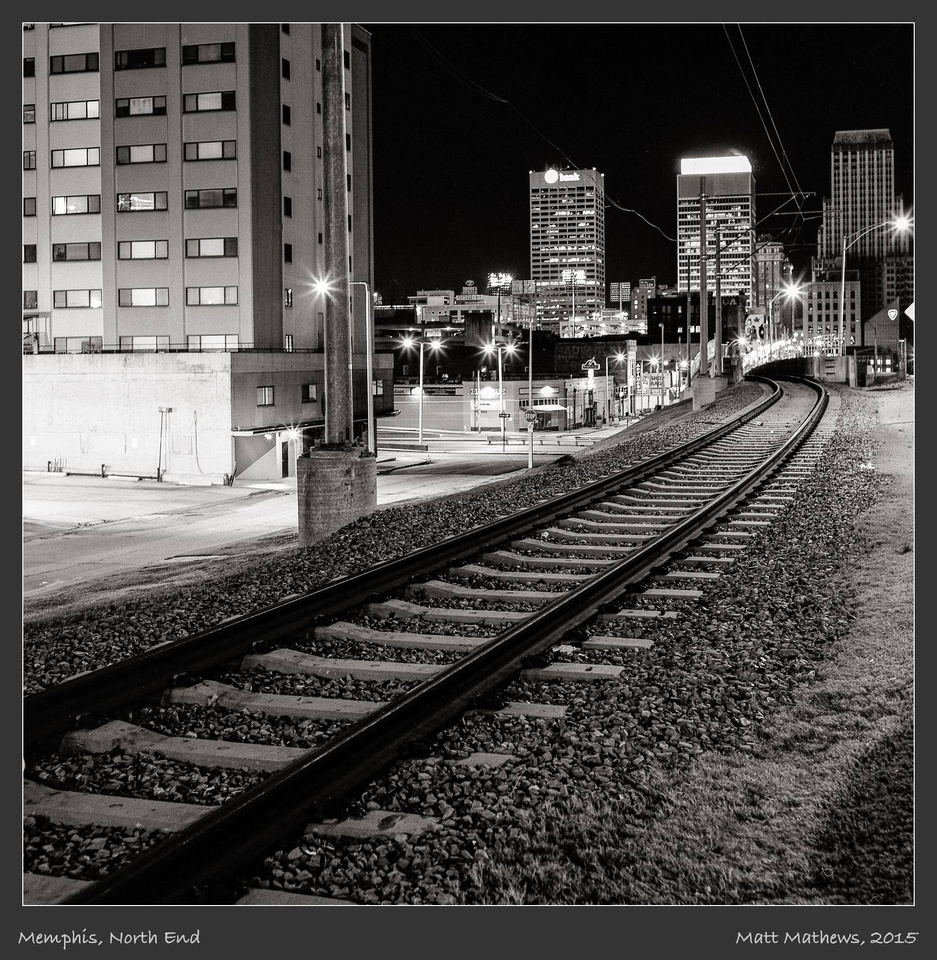

My current photography project, "Memphis by Night," is inspired by Brassaï, the great Hungarian photographer who photographed Paris at night in the early 1930s and eventually published a collection of these photographs as Paris by Night in 1932.
Paris had installed its first gas-lit street lights in 1828, the first city to do so, and with them Parisians redeemed the night for public life. Wandering the "City of Light" at night, usually alone but occasional with a friend or two, Brassaï grew fascinated by the dramatically different appearance of the city. The moody shadows, the uneven lighting created by street lights playing on surfaces of buildings and streets, and the moody, misty light diffused by fog captivated him. In the night, even the small public toilet kiosks that were then common fixtures along Parisian streets seemed like little enchanted castles. With them, the cobblestones, trees, and park benches became a dreamy, noir tableau.
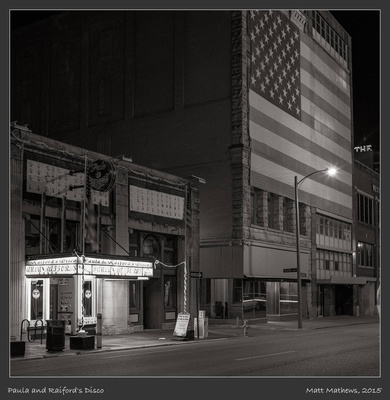 Paula and Raiford's Disco, 2015
Paula and Raiford's Disco, 2015
But it was not the city alone that changed at night. So did its inhabitants. Brassaï turned his camera on lovers embracing in the privacy of dark parks, prostitutes courting the attention of potential johns, and the invisible workers of the night -- butchers, delivery persons, rag collectors, police officers, street repair crews, and others whose work often prepared the city for life by day.
From the moment I first opened my anthology of Brassaï's photographs, I was intrigued. I had never really explored any city at night with creative or visual depth. And so, after living with Brassaï's work for several years, I decided to wander Memphis at night, and I decided to do so with an old medium format film camera from the early 1960s as fully manual and nearly as clumsy as Brassai's Voigtländer Bergheil camera.
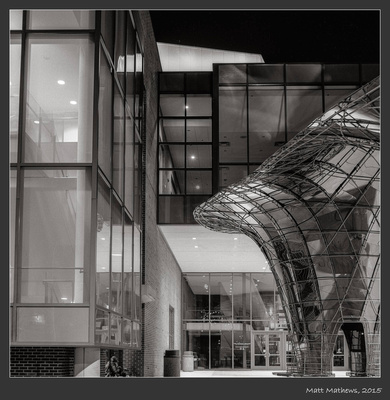 Homeless Man and Architecture, Cannon Center, 2015
Homeless Man and Architecture, Cannon Center, 2015 Much like Brassaï, when I go out at night, I go as a flâneur -- a walking drifter, an aimless wanderer persistently available to whatever Memphis by night wants to reveal. I have ideas, hunches, and instincts that I follow, of course, but nothing is a sure bet, and there are always surprises and much improvisation. I wander dark alleys where I hear squeaking rodents and see chefs out smoking on their breaks. Other times I meet homeless people huddled in obscure corners or young professionals moving between bars, restaurants, and sporting events. Then there's the occasional security guard, underpaid and hungry for validation, who meets me with suspicion or excessive chattiness.
Much like Brassaï, when I go out at night, I go as a flâneur -- a walking drifter, an aimless wanderer persistently available to whatever Memphis by night wants to reveal. I have ideas, hunches, and instincts that I follow, of course, but nothing is a sure bet, and there are always surprises and much improvisation. I wander dark alleys where I hear squeaking rodents and see chefs out smoking on their breaks. Other times I meet homeless people huddled in obscure corners or young professionals moving between bars, restaurants, and sporting events. Then there's the occasional security guard, underpaid and hungry for validation, who meets me with suspicion or excessive chattiness.
Sometimes people express interest and talk to me, but mostly they ignore me. Some look quizzically in the direction where my camera is pointed, puzzled and wondering what on earth could possibly be worthy of a picture. They are puzzled because they are still seeing and living as day people in the night world.
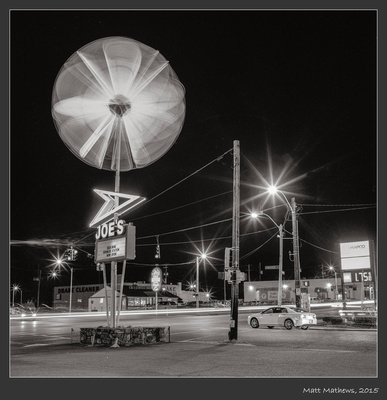 Sputnik at Joe's Liquor, 2015
Sputnik at Joe's Liquor, 2015 With "Memphis by Night," my aim is not merely to imitate Brassaï. I have focused far less on the people and far more on the cityscape of the night. I am especially intrigued by the way the long exposures required by night film photography capture the blurred movement of people, cars, water, spinning signs, and public art. Such movement did not seem to interest Brassaï. And in an age in which the camera has become a suspicious instrument of universal surveillance, I cannot take the camera into bars, restaurants, or hotels to photograph people as Brassaï did eighty-five years ago. Night-lit architecture calls me instead.
With "Memphis by Night," my aim is not merely to imitate Brassaï. I have focused far less on the people and far more on the cityscape of the night. I am especially intrigued by the way the long exposures required by night film photography capture the blurred movement of people, cars, water, spinning signs, and public art. Such movement did not seem to interest Brassaï. And in an age in which the camera has become a suspicious instrument of universal surveillance, I cannot take the camera into bars, restaurants, or hotels to photograph people as Brassaï did eighty-five years ago. Night-lit architecture calls me instead.
In the end, though, I have come to share Brassaï's insight, tinged as it is by surrealism, that "[n]ight does not show things, it suggests them. It disturbs and surprises us with its strangeness. It liberates forces within us which are dominated by reason during the daytime."*
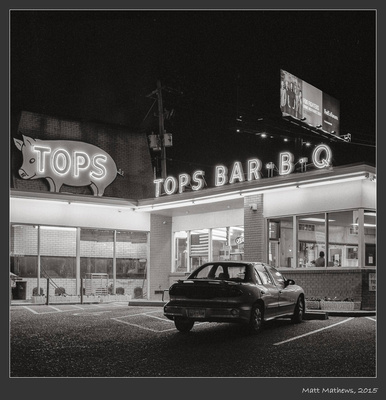 Tops Bar-B-Q, 2015
Tops Bar-B-Q, 2015
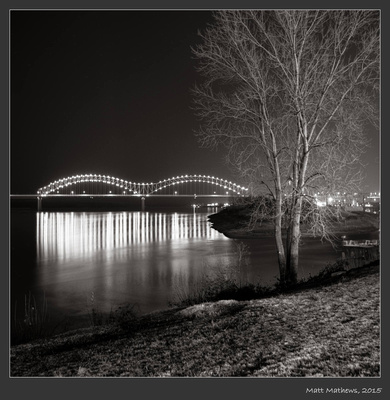 Mississippi River and Hernando DeSoto Bridge, 2015
Mississippi River and Hernando DeSoto Bridge, 2015
----------------------
*quoted in Jean-Claude Gautrand, ed., Brassai: Paris (Koln: Taschen, 2008); p. 32
The Windows of Simpson UMC -- Buy the Book
My book of 36 photographs of the the stained-glass windows of Simpson United Methodist Church, Evansville, Ind. is available for purchase online. See details below. You may also download a free E-book version below.
There are three purchasing options:
Option 1: An 8” x 10” Soft Cover Book available for $24.49 plus shipping. Click Here
Option 2: An 8” x 10” Hard Cover Book available for $36.49 plus shipping. Click Here
Option 3: A 13” x 11” Hard Cover Book available for $60.19 plus shipping. Click Here
Free E-Book:
To download the free E-Book version, which is great for tablets such as iPad or Kindle, click below. Since tablets vary, I cannot supply viewing instructions. Your tablet will need a PDF-reader program, and most have one already installed.
If you are using an iPad, click on the link below, download the file by touching the download icon (downward facing arrow at bottom right of screen). Once the E-book opens in your browser, touch in the upper right of the viewing area and you can transfer the E-book to the iBooks app and it will be viewable as a book in your library.
Click Here to Download Free PDF E-Book
The content of the book is the same across all print versions and E-Book versions.
The Allure of Film in the Digital Age


Invitation & Artist Statement for "People"
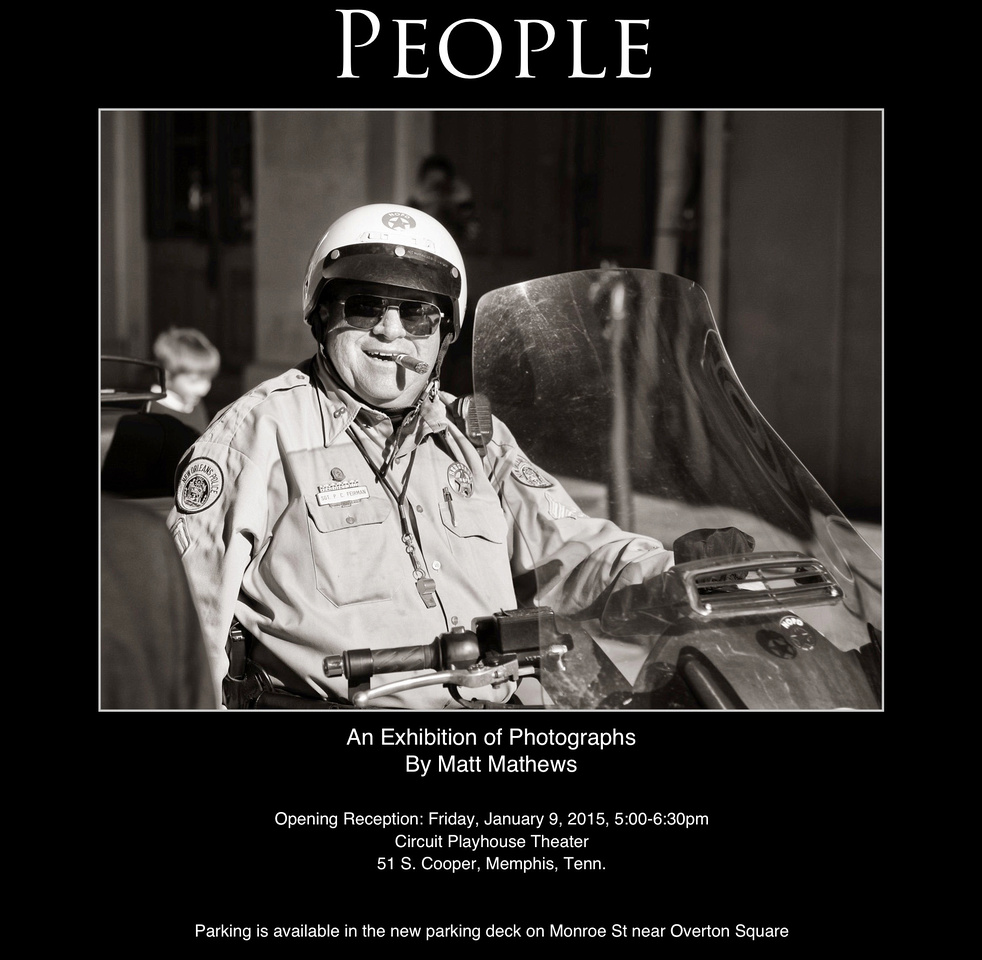

"We're born naked, and the rest is drag."
-- RuPaul, Drag Queen
